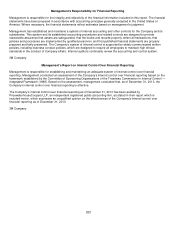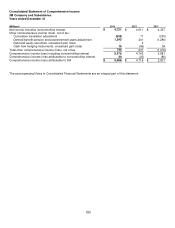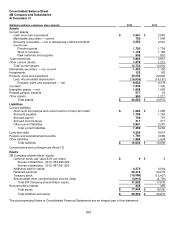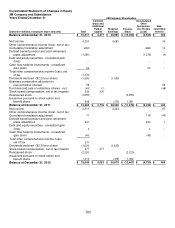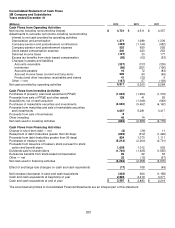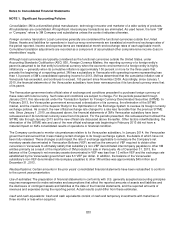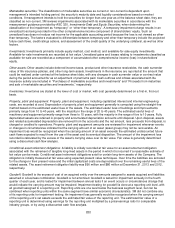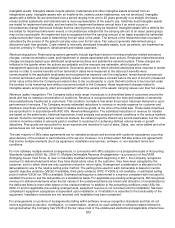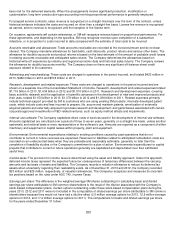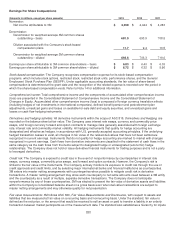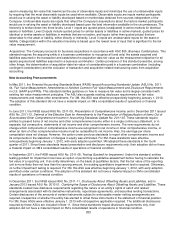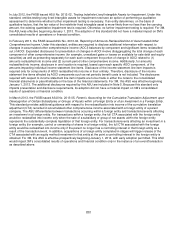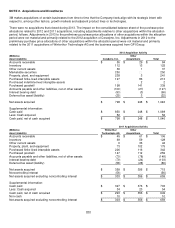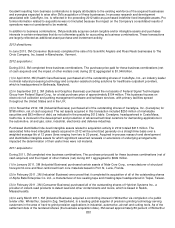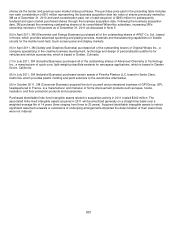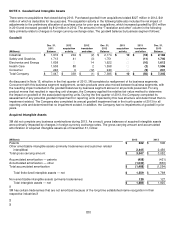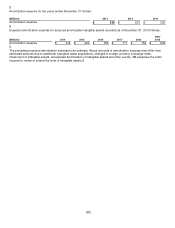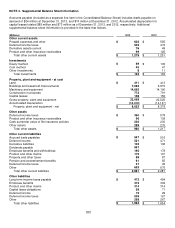3M 2013 Annual Report Download - page 60
Download and view the complete annual report
Please find page 60 of the 2013 3M annual report below. You can navigate through the pages in the report by either clicking on the pages listed below, or by using the keyword search tool below to find specific information within the annual report.54
Intangible assets: Intangible assets include patents, tradenames and other intangible assets acquired from an
independent party. Intangible assets with an indefinite life, namely certain tradenames, are not amortized. Intangible
assets with a definite life are amortized over a period ranging from one to 20 years generally on a straight line basis,
unless another systematic and rational basis is more representative of the asset’s use. Indefinite-lived intangible assets
are tested for impairment annually, and are tested for impairment between annual tests if an event occurs or
circumstances change that would indicate that the carrying amount may be impaired. Intangible assets with a definite life
are tested for impairment whenever events or circumstances indicate that the carrying amount of an asset (asset group)
may not be recoverable. An impairment loss is recognized when the carrying amount of an asset exceeds the estimated
undiscounted cash flows used in determining the fair value of the asset. The amount of the impairment loss recorded is
calculated by the excess of the asset’s carrying value over its fair value. Fair value is generally determined using a
discounted cash flow analysis. Costs related to internally developed intangible assets, such as patents, are expensed as
incurred, primarily in “Research, development and related expenses.”
Restructuring actions: Restructuring actions generally include significant actions involving employee-related severance
charges, contract termination costs, and impairment of assets associated with such actions. Employee-related severance
charges are largely based upon distributed employment policies and substantive severance plans. These charges are
reflected in the quarter when the actions are probable and the amounts are estimable, which typically is when
management approves the associated actions. Severance amounts for which affected employees were required to render
service in order to receive benefits at their termination dates were measured at the date such benefits were
communicated to the applicable employees and recognized as expense over the employees’ remaining service periods.
Contract termination and other charges primarily reflect costs to terminate a contract before the end of its term (measured
at fair value at the time the Company provided notice to the counterparty) or costs that will continue to be incurred under
the contract for its remaining term without economic benefit to the Company. Asset impairment charges related to
intangible assets and property, plant and equipment reflect the excess of the assets’ carrying values over their fair values.
Revenue (sales) recognition: The Company sells a wide range of products to a diversified base of customers around the
world and has no material concentration of credit risk. Revenue is recognized when the risks and rewards of ownership
have substantively transferred to customers. This condition normally is met when the product has been delivered or upon
performance of services. The Company records estimated reductions to revenue or records expense for customer and
distributor incentives, primarily comprised of rebates and free goods, at the time of the initial sale. These sales incentives
are accounted for in accordance with ASC 605, Revenue Recognition. The estimated reductions of revenue for rebates
are based on the sales terms, historical experience, trend analysis and projected market conditions in the various markets
served. Since the Company serves numerous markets, the rebate programs offered vary across businesses, but the most
common incentive relates to amounts paid or credited to customers for achieving defined volume levels or growth
objectives. Free goods are accounted for as an expense and recorded in cost of sales. Sales, use, value-added and other
excise taxes are not recognized in revenue.
The vast majority of 3M’s sales agreements are for standard products and services with customer acceptance occurring
upon delivery of the product or performance of the service. However, to a limited extent 3M also enters into agreements
that involve multiple elements (such as equipment, installation and service), software, or non-standard terms and
conditions.
For non-software multiple-element arrangements, in connection with 3M’s adoption on a prospective basis of Accounting
Standards Updated (ASU) No. 2009-13, Multiple-Deliverable Revenue Arrangements—a consensus of the FASB
Emerging Issues Task Force, to new or materially modified arrangements beginning in 2011, the Company recognizes
revenue for delivered elements when they have stand-alone value to the customer, they have been accepted by the
customer, and for which there are only customary refund or return rights. Arrangement consideration is allocated to the
deliverables by use of the relative selling price method. The selling price used for each deliverable is based on vendor-
specific objective evidence (VSOE) if available, third-party evidence (TPE) if VSOE is not available, or estimated selling
price if neither VSOE nor TPE is available. Estimated selling price is determined in a manner consistent with that used to
establish the price to sell the deliverable on a standalone basis. For applicable pre-existing arrangements, 3M recognizes
revenue for delivered elements when the fair values of the undelivered items are known and allocation of consideration to
the delivered items is most often based on the residual method. In addition to the preceding conditions under ASU No.
2009-13 and for applicable pre-existing arrangements, equipment revenue is not recorded until the installation has been
completed if equipment acceptance is dependent upon installation or if installation is essential to the functionality of the
equipment. Installation revenues are not recorded until installation has been completed.
For arrangements (or portions of arrangements) falling within software revenue recognition standards and that do not
involve significant production, modification, or customization, revenue for each software or software-related element is
recognized when the Company has VSOE of the fair value of all of the undelivered elements and applicable criteria have


